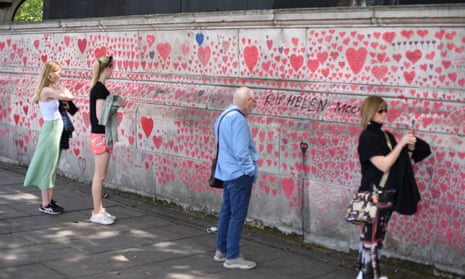Memorials aim to be an eloquent last word on an event. A key quality is that they resist change: they attempt to fix for us an abiding sense of what exactly has happened. They can be many things: columns, tombs, plaques, cenotaphs, village halls, even housing. But who are they for? The people who suffered, their families, the wider public or future generations?
At some point, inevitably, there will be an official, national memorial of the pandemic in the UK (as well as many more, surely, at local and international levels). What, then, should it look like? It will have to contend with how messy the past year has been – the death, the sorrow, the fear, but also the ensuing political and social division. Perhaps through all of that, memorialisation can play a therapeutic role.
Memorials naturally remove some of the complexity of the past, replacing it with something smoother, better suited to a broad audience: the tomb of the Unknown Warrior doesn’t address one specific loss, so it can talk of all loss. Because of this universal ambition it is vital public memorials hit the right tone – being both honest and broadly interpretable, tending to avoid friction. As a result, though, memorials can feel as if they don’t talk to you directly or seem too vague. But at a time when narratives are brutally contested, it seems unlikely that a pandemic memorial will avoid controversy, no matter how skilful the architect.
There have already been several attempts to memorialise the lives lost around the world during the pandemic, from the heartfelt and informal to the grandiose.
Most recently, St Paul’s Cathedral in London has announced it is fundraising to create a memorial from its online book of remembrance. Although these early expressions show there is a need to remember, none have fully grasped the scale of such an era-defining event.
Sir Edwin Lutyens, in designing the Cenotaph to remember those lost in the first world war, tackled the problem of remembering through abstraction. The calm, mute form reached beyond allusion or literal interpretation. Yet Lutyens’ attempt was criticised by Church of England bishops for being too ecumenical and secular.
After the first world war, the British government erected monuments to mark the conflict across the UK and the empire. They also built many memorial halls and in some cases social housing as a more ambitious tribute to the fallen. The idea originated after the Boer war, but by 1919 had expanded to whole “memorial villages”, which included traditional monuments to the dead but also housing and provision for employment. A good example of this can be found at Westfield War Memorial Village, Lancaster. The mundane everyday-ness of it somehow makes it all the the more poignant.
Site is crucial to how memorials work. Take London, where we have a kind of monument zone littered with commemoration, stretching from Trafalgar Square, down Whitehall, to Parliament Square and up to Hyde Park. The memorials sit next to places of power, marking them as an official record of events.
In the design of public memorials the pendulum has swung between abstraction and figuration. There is always a tension between the need to represent tangible things, and the need to go further, communicating a larger idea. Sometimes memorials suffer from being very literal: the 7 July Memorial in Hyde Park, for instance, has 52 stelae standing in for the 52 victims of the 2005 London bombings. It feels almost too direct.
More striking is the solemn presence of the recently unveiled memorial to Cherry Groce in Brixton, south London, which makes a political point. Groce was a black woman who was shot by the Metropolitan police in her own home in 1985. The incident left her paralysed, and ultimately killed her in 2011. The memorial, designed by David Adjaye, consists of a heavy solid triangle supported by a single column above a seating deck – all in immutable cast stone. There is an emphasis on the void beneath the structure, but then the seating also invites people to engage physically. The visible weight communicates something abstract about strength while also offering shelter. Topped by planting, it alludes to the potential for growth. Adjaye’s architecture uses abstraction to capture the ineffable nature of loss.
The pandemic is a unique, historically significant event, and should be commemorated as such. Ultimately a memorial to the pandemic will have to be for all: the dead, the survivors and future generations. Mass death is nothing new, but our shared year of distance and solitude is perhaps what sets this experience apart. The extended isolation, the screen-mediated existence, and the clear understanding that this disease affects us all: how can a memorial capture this?
Architecture can contain the inexpressible. The really hard job of remembrance can be communicated through dumb stone. It is pathetic, pitiful even, that sometimes the best we can do as a species when confronted with oblivion is to pile up stones and write names on them. But it remains a valuable way of commemorating not just the dead, but also the trauma of those who survived and the experience of the wider public.
Perhaps, taking a lesson from 100 years ago, we can contemplate a bigger leap and revisit some of the ethos of memorial villages. Building more social housing as an act of remembrance would be a way of making those piled-up stones mean something more. It would also serve to remind us of the extremely domestic experience the pandemic. And, given the importance of parks and open spaces throughout this time, why not invest more public money in them? We could have a living response to the incomprehensibility of death.
Eddie Blake is the director of architecture and research practice at Studio Palace in London
